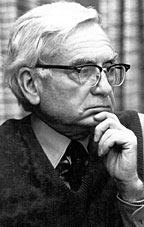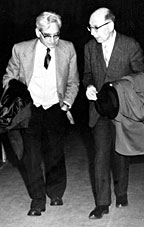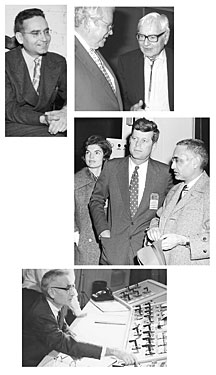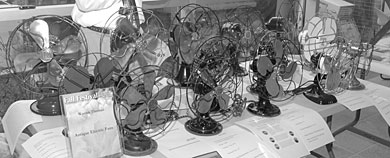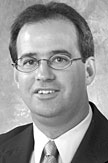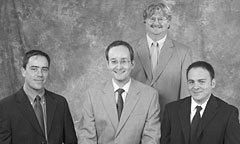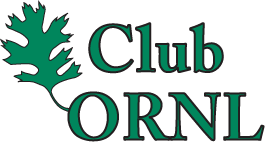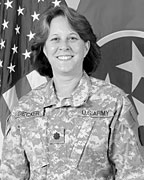 |
Number 83, November 2006 |
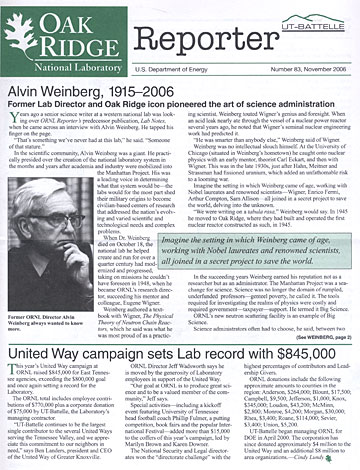 |
|
| Lab Notes | |
|
|
|
|
|
|
|
|
|
| Awards Night 2006 | |
Director's Awards |
|
| Retirement Program Plan Annual Report | |
| 278th’s Lt. Col. Decker breaks ground for women in command | |
| Roth 401(k): A new Savings Program feature |
 Alvin Weinberg, 1915–2006
Alvin Weinberg, 1915–2006
Former Lab Director and Oak Ridge icon pioneered the art of science administration
|
|
| Former ORNL Director Alvin Weinberg always wanted to know more. |
Years ago a senior science writer at a western national lab was looking over ORNL Reporter’s predecessor publication, Lab Notes, when he came across an interview with Alvin Weinberg. He tapped his finger on the page.
“That’s something we’ve never had at this lab,” he said. “Someone of that stature.”
In the scientific community, Alvin Weinberg was a giant. He practically presided over the creation of the national laboratory system in the months and years after academia and industry were mobilized into the Manhattan Project. His was a leading voice in determining what that system would be—the labs would for the most part shed their military origins to become civilian-based centers of research that addressed the nation’s evolving and varied scientific and technological needs and complex problems.
When Dr. Weinberg died on October 18, the national lab he helped create and run for over a quarter century had modernized and progressed, taking on missions he couldn’t have foreseen in 1948, when he became ORNL’s research director, succeeding his mentor and colleague, Eugene Wigner.
Weinberg authored a textbook with Wigner, The Physical Theory of Neutron Chain Reactors, which he said was what he was most proud of as a practicing scientist. Weinberg touted Wigner’s genius and foresight. When an acid leak nearly ate through the vessel of a nuclear power reactor several years ago, he noted that Wigner’s seminal nuclear engineering work had predicted it.
Imagine the setting in which Weinberg came of age, working with Nobel laureates and renowned scientists, all joined in a secret project to save the world. |
|---|
“He was smarter than anybody else,” Weinberg said of Wigner.
Weinberg was no intellectual slouch himself. At the University of Chicago (situated in Weinberg’s hometown) he caught onto nuclear physics with an early mentor, theorist Carl Eckart, and then with Wigner. This was in the late 1930s, just after Hahn, Meitner and
Strassman had fissioned uranium, which added an unfathomable risk to a looming war.
Imagine the setting in which Weinberg came of age, working with Nobel laureates and renowned scientists—Wigner, Enrico Fermi, Arthur Compton, Sam Allison—all joined in a secret project to save the world, delving into the unknown.
“We were writing on a tabula rasa,” Weinberg would say. In 1945 he moved to Oak Ridge, where they had built and operated the first nuclear reactor constructed as such, in 1945.
In the succeeding years Weinberg earned his reputation not as a researcher but as an administrator. The Manhattan Project was a sea-change for science. Science was no longer the domain of rumpled, underfunded professors—genteel poverty, he called it. The tools required for investigating the realms of physics were costly and required government—taxpayer—support. He termed it Big Science.
ORNL’s new neutron scattering facility is an example of Big
Science.
Science administrators often had to choose, he said, between two projects. “Which is more valuable and should receive funding?” he asked. In 1993, in a collection of his writings titled Nuclear Reactions: Science and Trans-Science, Weinberg outlined three criteria of Big Science: technological merit, social merit and scientific merit.
After World War II, the atom became in many eyes the answer to all problems that were energy related. Nuclear power could purify water, dig holes, power artificial hearts, cure illness, light the night and explore the cosmos. The Weinbergs of the time shared the optimism but knew it wasn’t that simple. Wigner foresaw that the mushroom cloud would shadow nuclear energy’s acceptability with the public. Still, ORNL grew as the leading nuclear engineering laboratory—nobody did nuclear reactors better than Weinberg’s ORNL, which developed technologies and trained a generation that spawned, among other legacies, the nuclear navy.
|
|
| Former ORNL Director Alvin Weinberg always wanted to know more. |
Not everything panned out. Weinberg said he recognized that the idea of a nuclear-powered airplane was daft at the outset, but the funds the government poured into it sustained ORNL in a lean time and spawned many important and enduring programs.
He said that the production of radioisotopes for medical uses might be the greatest contribution of ORNL and its first nuclear reactor. Along with many others he envisioned a smokestackless world of cheap and abundant nuclear power.
It must have been devastating to see the First Nuclear Era, as he called it, collapse when the Three-Mile Island and Chernobyl mishaps gutted public and political support of nuclear energy. But it might have been gratifying to see the issue of fossil-fuel-induced climate change lend support to the idea of a second nuclear era.
Weinberg was named ORNL director in 1955 and left the job in 1974 in a kerfuffle with Washington, “at an appropriate time” nevertheless, he said. But he never left Oak Ridge.
He did spend a year in a Washington think tank. “Except nobody told us what to think about,” he said. He and his fellow thinkers came up with the Solar Energy Research Institute, which evolved into the National Renewable Energy Laboratory. His ideas tended to stick.
|
|
| Clockwise from top left: Weinberg when both he and ORNL were pretty young, with former Sen. Howard Baker in 2000, with the Kennedys in 1959. |
Just as he championed science, he also was an advocate for bringing the science message to the nontechnical public. He chaired the Kennedy Administration’s Panel of Science Information, which issued a report titled “Science, Government, and Information,” but was mostly known as “the Weinberg Report.”
In later years Weinberg maintained an office in town at Oak Ridge Associated Universities and continued to work and confer with scientists and policymakers.
His ORNL visits were frequent. He drove himself out to the Lab in 2001 for the Holifield Facility’s 20th anniversary celebration. He showed up at the Graphite Reactor’s 50th anniversary luncheon with a truckers cap perched atop a bandaged head. He had fallen and skinned his noggin playing tennis, which he played into his eighties.
He also played piano. The living room in his expanded government “F” house on Moylan Lane was dominated by a grand piano, his “pride and joy.” He was a gardener, and he gave gardening tips to the neighborhood kids he let play in his yard.
As Lab Director Weinberg struck fear into the hearts of lecturers with his probing followup questions. When he attended seminars in later years, he always sat at the front and could usually be counted on to want to know something more.
Alvin Weinberg wanted humankind to use the atom for good things. He was the foremost proponent of Oak Ridge’s Friendship Bell, a symbol of friendship between the city and Japan, and maintained that the atom bomb attacks on two of that nation’s cities were such terrible events that they have spawned a sanctified tradition of nonuse of nuclear weapons.
“We must invest that tradition with a religious aura,” he said.
The American Nuclear Society, which he helped established, awards a Weinberg Medal “for contributions to the understanding of the social implications of nuclear technology.” ORNL named an auditorium after Weinberg and a lecture series. The city of Oak Ridge, which counted him as one of its greatest assets, named a street after him. More namesake streets and buildings and awards will surely follow.
When the Oak Ridge community celebrated his 90th birthday last year, Weinberg reveled in the roomful of well-wishers and was engaged enough to attend the following State of the Laboratory talk by the current ORNL Director, Jeff Wadsworth.
And he asked a pretty tough question at the end of it.—B.C ![]()
 United Way campaign sets Lab record with $845,000
United Way campaign sets Lab record with $845,000
This year’s United Way campaign at ORNL raised $845,000 for East Tennessee agencies, exceeding the $800,000 goal and once again setting a record for the
Laboratory.
The ORNL total includes employee contributions of $770,000 plus a corporate donation of $75,000 by UT-Battelle, the Laboratory’s managing contractor.
“UT-Battelle continues to be the largest single contributor to the several United Ways serving the Tennessee Valley, and we appreciate this commitment to our neighbors in need,” says Ben Landers, president and CEO of the United Way of Greater Knoxville.
ORNL Director Jeff Wadsworth says he is moved by the generosity of Laboratory employees in support of the United Way.
“Our goal at ORNL is to produce great science and to be a valued member of the community,” Jeff says.
Special activities—including a kickoff event featuring University of Tennessee head football coach Phillip Fulmer, a putting competition, book fairs and the popular International Festival—added more than $15,000 to the coffers of this year’s campaign, led by Marilyn Brown and Karen Downer.
The National Security and Legal directorates won the “directorate challenge” with the highest percentages of contributors and Leadership Givers.
ORNL donations include the following approximate amounts to counties in the region: Anderson, $264,000; Blount, $17,500; Campbell, $9,500; Jefferson, $1,000; Knox, $345,000; Loudon, $43,200; McMinn, $2,800; Monroe, $4,200; Morgan, $30,000; Rhea, $3,400; Roane, $114,000; Sevier, $3,400; Union, $5,200.
UT-Battelle began managing ORNL for DOE in April 2000. The corporation has since donated approximately $4 million to the United Way and an additional $8 million to area organizations.—Cindy Lundy ![]()
 |
 Delighted to have you
Delighted to have you
ORNL gained a couple of U.S. citizens last month. One of them happens to be a member of the Leadership Team.
In a ceremony in Greeneville, Neutron Sciences Associate Lab Director Thom Mason and the Computational Sciences & Engineering Division’s Arjun Shankar took the oath of allegiance to become United States citizens.
Although citizenship obviously makes many things easier with respect to working at a federal research laboratory, both Thom and Arjun say the move was personal.
|
|
| Mason |
“I can do things like directly approve foreign-nationals’ access now, but it’s more for personal reasons, like being able to vote. And the kids—this is home to them,” Thom, a native of Canada, says.
Arjun, who comes from India, agrees. “This is home. We’ve been in the U.S. 14 years, and we’re very American. It just makes sense overall,” he says.
Both Thom and Arjun note that the process is bureaucratically complex and fraught with roadblocks. Thom’s wife, Jennifer, received her citizenship a few months earlier, likely, he says, because she hasn’t traveled internationally as much.
|
|
| Shankar |
“It’s impenetrable. You have to list all the times you’ve been out of the country.”
Thom credits the “kids,” for coaching him through some of the requisite civics lessons and the Lab for helping him through some of the roadblocks. “People not at a place like the Lab would have trouble walking through the maze,” he says.
Nevertheless, the immigration folks, when they could be contacted, were always courteous, if overwhelmed.
The Security Department’s Debbie Gray says naturalizations aren’t uncommon among Lab employees, averaging about a dozen a year. For Americans, that’s good news.
“I know I’m contributing to the country,” Arjun says.
 Workers help a brother
Workers help a brother
Last month Reporter had a story about improvements in safety statistics at the Lab. Much of that improvement is in the Facilities and Operations Directorate, and F&O staff members have been rewarded for working safely with $50 gift cards.
Many of the cards are being put to good use—helping a co-worker in need.
Recently, a new Craft Resources employee, Jimmy Kitchens, was diagnosed with a serious, though nonmalignant, tumor. He hasn’t been employed long enough to qualify for disability benefits, and his plight was potentially devastating to the family: Jimmy’s wife is also out of work with back problems.
Numerous F&O staff members have donated their gift cards to Kitchens, as well as vacation days and meals.
Atomic Trades & Labor Council Vice President Carl Wright and steward John Trotter say about 50 gifts cards have been donated to the family. An account at the ORNL Federal Credit Union has also been set up for Jimmy’s family.
Meanwhile, Gene Kitchens, Jimmy’s father who works at the High Flux Isotope Reactor, says his son is recovering.
 Cutting composite costs in cars
Cutting composite costs in cars
ORNL, joined by visitors from DOE’s Energy Research & Renewable Energy program office, dedicated its Low-Cost Carbon Fiber Processing and Manufacturing Research Facilities on October 24. The laboratory is located in the Engineering Technology Facility on the east campus.
The facility, led by the Materials S&T Division’s Bob Norris, specializes in investigating materials and techniques that will reduce carbon fiber and composite production costs enough to make the tough and lightweight materials competitive with traditional automotive materials.
Carbon fiber composites are seen as a key to getting weight down on vehicles without sacrificing durability. The main roadblock, no pun intended, is their cost. ORNL is leading EERE’s efforts to find ways to reduce production costs to the point where they can replace metals. Studies indicate that low-cost carbon fiber composites could reduce the weight of cars by more than 40 percent and increase fuel economy by more than 25 percent.
Ray Boeman, the Lab’s FreedomCAR and Vehicle Technologies program manager, says those are big wins in terms of increased fuel economy and reduced carbon emissions.
On hand for the dedication were EERE Principal Deputy Assistant Secretary John Mizroch and Ed Wall and Joe Carpenter with EERE’s FreedomCAR & Vehicle Technologies Program.. Partners include the Automotive Composites Consortium, Pacific Northwest National Laboratory, MeadWestvaco, and Weyerhaeuser.
—Reported by Bill Cabage |
|
|
|
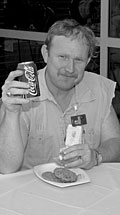 |
Fall Festival fans, and a Fall Festival fan Club ORNL held its second Fall Festival on October 26. The lunchtime celebration included a meal of chicken or bratswurst and a number of impressive craft and hobby displays by Lab employees, including this collection of antique fans, gathered by Warren Thomas. Enjoying dessert on the Conference Center plaza at left is F&O’s Mark Russell. |
 Awards Night 2006
Awards Night 2006
ORNL recognizes the year’s outstanding accomplishments
ORNL’s outstanding accomplishments in the areas of science and technology, Laboratory operations and community service were honored on November 3 at the annual Awards Night. Congratulations to this year’s winners, and to the individual and team winners of this year’s Director’s Awards.
Operations Support
Secretarial Support
Sheila Moore, Engineering Science and Technology Division, for exceptional assistance to the Center for Transportation Analysis Director; for independently securing funds to conduct workshops; and for ensuring that the public sees CTA as a polished, professional, and technically advanced organization
Technical Support
Lara James, Networking & Computing Technologies Division, for continually enhancing staff productivity while providing exceptional desktop PC support regardless of how difficult the situation, while treating people with kindness and with the utmost respect
Administrative Support, Nonexempt
Payroll
Kathy L. Johnson, Engineering S&T Division, for her exceptional and instrumental efforts in instituting significant efficiency improvements and cost savings in the management of the Analysis, Characterization, and Technical Support Program.
Administrative Support, Exempt Payroll or Team
Thomas B. Ballard, Vivian M. Baylor, Markus A. Camfield, Wilson D. Lannom Jr., John A. Stephen O’Neil, Sonny Rogers and Margaret Spurlin, multiple organizations, for excellence in Laboratory operations in support of the Department of Homeland Security’s Southeast Regional Research initiative
Excellence in Safety Leadership
John B. Czachowski, Sharon L. Byrd and Thomas V. Dinsmore, Engineering S&T Division, for developing and implementing a site-specific training module for Laboratory space managers that has made substantial improvement in the operational effectiveness of ESTD’s experimental activities
Integrated Safeguards and Security
Management
Charles S. Webster, Nuclear S&T Division, for dedicated service, breadth of knowledge, and important contributions in ensuring Cyber Security program effectiveness within the Nuclear S&T Division and across the Laboratory
Administrative & Operations Leadership, at the Group Level
John A. Wheeler, Engineering S&T Division, for exceptional management skills which have been critical to the success of the division.
Administrative & Operations Leadership, at the Director Level
Timothy P. Powers, Nonreactor Nuclear Facilities Division, for exceptional leadership in the Nonreactor Nuclear Facilities Division in a period of transition and challenge
Bargaining Unit Support by a Team
Jerry Tolliver, David Adaline, John B. Brock, David M. Christopher, Donald V. Johnson, R. F. (Bob) Johnston, Ed Long,
K. E. McNabb, Michael Smith and Rupert G. Smith, Craft Resources Division, for exemplary performance in support of a major research project that required unique and innovative fabrication techniques and processes.
Operations Support by a Team
Steffon C. Riser, Teresa Baer, Glenn D. Buckley, Kahra Gilley, James E. (Ed) Lee, C. Gregory Palko, Mark A. Spann and Joe G. Whedbee, Facilities Management Division, for an exceptional team effort in the successful implementation of a new facilities management approach demonstrating ORNL stewardship of real property assets and providing well-maintained facilities to enable world-class science
Community Service
Exceptional Community Outreach by an Individual
Joseph N. Herndon, Energy and Engineering Sciences Directorate, for an exceptional and sustained record of volunteerism and service in humanitarian causes in the Knoxville area and beyond
Exceptional Community Outreach by a Team
Linda L. Duncan, Maggie Miller and Nancy E. Spiers, Networking & Computing Technologies Division and Office of the Chief Information Officer, for helping and benefiting the Battered Women’s Shelter by enhancing the quality of life for many women and children who have no other place to go in times of despair
Esprit de Corps
Bonnie B. Hébert, Hassina Bilheux, Nancy L. Gray, Dana C. Green, Joan W. Lawson, Vickie C. McGinty, Regina H. Meredith, Leigha Stewart, Peggy J. Tinnel and Ross J. Toedte, multiple organizations, for sustained and significant contributions to the successful launch of Club ORNL as a highly visible organization that is building a strong sense of community among Laboratory staff
Community Leadership
Sherry Livengood, Engineering S&T Division, for selfless dedication and personal commitment to Habitat for Humanity of Anderson County
Science Communicator
Michael S. Smith, Physics Division, for excellence in communicating the excitement of physics research, notably astrophysics and modern nuclear physics research, to the general public and to students considering science careers
Science and Technology
Technical Support
David A. Everitt, Fabio Gasagrande, Allen Crabtree, Matthew P. Howell, Gary A. Johnson, Thomas S. Neustadt, F. Stephen Proffitt, Manuel Santana and David M. Vandygriff, multiple organizations, for heroic efforts in disassembling, repairing, re-assembling and re-installing the Spallation Neutron Source’s inner reflector plug in just under the required six weeks, thereby allowing the SNS project to meet its completion milestone
Early Career Award for Engineering Accomplishment
Sara A. Pozzi, Nuclear S&T Division, for development of the MCNP-PoliMi code and its application to the design and analysis of correlation measurements in the field of nuclear materials identification
Early Career Award for Scientific Accomplishment
Elissa J. Chesler, Biosciences Division, for outstanding contributions to the analysis of complex genetic traits and demonstrating expertise in statistical genetics and data integration/analysis, with a particular focus in neuroscience
R&D Leadership at the Group Level
David M. Hetrick, Computational Sciences & Engineering Division, for outstanding and exemplary leadership of the division’s Modeling and Simulation group and program development leadership
R&D Leadership at the Director Level
Ian Anderson, SNS Experimental Facilities Division, for exemplary performance in managing the installation of the SNS target and instruments—on schedule and within budget—and for developing a strategy for the long-term success of the ORNL Neutron Science Program
Excellence in Technology Transfer
M. Parans Paranthaman, Tolga Aytug and Amit Goyal, Chemical Sciences Division and Materials S&T Division, for the development, patenting, and transfer of high throughput buffer layer technology being commercialized by SuperPower, Inc., that enabled the achievement of world record performance in SuperPower’s long-length, second-generation superconducting wires
Inventor of the Year
Gregory Richard Hanson, Engineering S&T Division, for the development of intellectual property portfolios related to energy-environmental control and national security
Engineering Research and Development
Jonathan A. Demko, Robert Duckworth, Alvin R. Ellis, Paul W. Fisher, Michael J. Gouge, D. Randy James, David T. Lindsay, Christopher M. Rey, Mark Roden, Isidor Sauers and Jerry C. Tolbert, Fusion Energy Division and Ultera (Southwire, Consultant, Paul Fisher), for the invention, development, design, fabrication and successful testing of the world’s most compact power cable
Scientific Research
Brian J. Rodriguez, Arthur P. Baddorf, Stephen Jesse and Sergei V. Kalinin, Materials S&T Division, for the development of experimental methods and theoretical understanding leading to the first experimental demonstration of electromechanical response in a liquid, and discovery of superior unsurpassed resolution with piezoresponse atomic force microscopy
Distinguished Engineer
Stuart Daw, Engineering S&T Division, for sustained and significant engineering contributions to improve the performance of combustion and emissions control technologies
Distinguished Scientist
Virginia H. Dale, Environmental Sciences Division, for her scientific and personal accomplishments in advancing the science of ecology and our ability to manage precious natural resources ![]()
 Retirement Program Plan Annual Report
Retirement Program Plan Annual Report
Summary Annual Report for
RETIREMENT PROGRAM PLAN FOR EMPLOYEES OF CERTAIN EMPLOYERS AT THE U.S. DEPARTMENT OF ENERGY FACILITIES AT OAK RIDGE, TENNESSEE
This is a summary of the annual report for the RETIREMENT PROGRAM PLAN FOR EMPLOYEES OF CERTAIN EMPLOYERS AT THE U.S. DEPARTMENT OF ENERGY, (Employer Identification No. 54-1987297, Plan No. 001) for the period January 1, 2005 to December 31, 2005. The annual report has been filed with the Employee Benefits Security Administration, as required under the Employee Retirement Income Security Act of 1974 (ERISA).
BASIC FINANCIAL STATEMENT
Benefits under the plan are provided by a trust (benefits are provided in whole from trust funds). Plan expenses were $172573416. These expenses included $17170157 in administrative expenses and $155,403,259 in benefits paid to participants and beneficiaries. A total of 23,082 persons were participants in or beneficiaries of the plan at the end of the plan year, although not all of these persons had yet earned the right to receive benefits. The value of plan assets, after subtracting liabilities of the plan, was $2,943,401,507 as of December 31, 2005 compared to $2,861,239,681 as of January 1, 2005. During the plan year the plan experienced an increase in its net assets of $82,161,826. This increase includes unrealized appreciation or depreciation in the value of plan assets; that is, the difference between the value of the plan’s assets at the end of the year and the value of the assets at the beginning of the year, or the cost of assets acquired during the year. The plan had total income of $257,903,430, including gains of $4,554,288 from the sale of assets and earnings from investments of $253,349,142. The plan has contracts with Metlife and The Prudential Insurance Company of America which allocate funds toward individual policies.
MINIMUM FUNDING STANDARDS
An actuary’s statement shows that enough money was contributed to the plan to keep it funded in accordance with the minimum funding standards of ERISA.
YOUR RIGHTS TO ADDITIONAL INFORMATION
You have the right to receive a copy of the full annual report, or any part thereof, on request. The items listed below are included in that report:
1. An accountant’s report;
2. Assets held for investment;
3. Transactions in excess of 5 percent of the plan assets;
4. Insurance information including sales commissions paid by insurance carriers;
5. Information regarding any common or collective trust, pooled separate accounts, master trusts or 103-12 investment entities in which the plan participates; and
6. Actuarial information regarding the funding of the plan.
To obtain a copy of the full annual report, or any part thereof, write or call the office of the Plan Sponsor
BWXT Y-12, L.L.C.
P.O. Box 2009, MS8267
Oak Ridge, TN 37830
54-1987297 (Employer Identification Number) 865-574-9110
You also have the right to receive from the plan administrator, on request and at no charge, a statement of the assets and liabilities of the plan and accompanying notes, or a statement of income and expenses of the plan and accompanying notes, or both. If you request a copy of the full annual report from the plan administrator, these two statements and accompanying notes will be included as part of that report. These portions of the report are furnished without charge.
You also have the legally protected right to examine the annual report at the main office of the plan:
BWXT Y-12, L.L.C.
P.O.Box 2009, MS8267
Oak Ridge, TN 37830
and at the U.S. Department of Labor in Washington, D.C., or to obtain a copy from the U.S. Department of Labor upon payment of copying costs. Requests to the Department should be addressed to: U.S. Department of Labor, Employee Benefits Security Administration, Public Disclosure Room, 200 Constitution Avenue, NW, Suite N-1513, Washington, D.C. 20210.
Summary Annual Report for
SAVINGS PROGRAM FOR EMPLOYEES OF CERTAIN EMPLOYERS AT THE U.S. DEPARTMENT OF ENERGY FACILITIES AT OAK RIDGE, TENNESSEE
This is a summary of the annual report for the SAVINGS PROGRAM FOR EMPLOYEES OF CERTAIN EMPLOYERS AT THE U.S. DEPARTMENT OF ENERGY FACILITIES AT, (Employer Identification No. 54-1987297, Plan No. 009) for the period January 1, 2005 to December 31, 2005. The annual report has been filed with the Employee Benefits Security Administration, as required under the Employee Retirement Income Security Act of 1974 (ERISA).
BASIC FINANCIAL STATEMENT
Benefits under the plan are provided by a trust (benefits are provided in whole from trust funds). Plan expenses were $68,273,965. These expenses included $784,534 in administrative expenses and $67,489,431 in benefits paid to participants and beneficiaries. A total of 10,499 persons were participants in or beneficiaries of the plan at the end of the plan year, although not all of these persons had yet earned the right to receive benefits.
The value of plan assets, after subtracting liabilities of the plan, was $1,339,786,023 as of December 31, 2005 compared to $1,255,747,754 as of January 1, 2005. During the plan year the plan experienced an increase in its net assets of $84,038,269. This increase includes unrealized appreciation or depreciation in the value of plan assets; that is, the difference between the value of the plan’s assets at the end of the year and the value of the assets at the beginning of the year, or the cost of assets acquired during the year. The plan had total income of $152,312,234, including employer contributions of $19,534,877, employee contributions of $53,759,337, gains of $12,922,376 from the sale of assets and earnings from investments of $63,827,042. The plan has a contract with Metropolitan Life Insurance Company which allocates funds toward individual policies.
MINIMUM FUNDING STANDARDS
Enough money was contributed to the plan to keep it funded in accordance with the minimum funding standards of ERISA.
YOUR RIGHTS TO ADDITIONAL INFORMATION
You have the right to receive a copy of the full annual report, or any part thereof, on request. The items listed below are included in that report:
1. An accountant’s report;
2. Financial information and information on payments to service providers;
3. Assets held for investment;
4. Insurance information including sales commissions paid by insurance carriers; and
5. Information regarding any common or collective trust, pooled separate accounts, master trusts or 103-12 investment entities in which the plan participates.
To obtain a copy of the full annual report, or any part thereof, write or call the office of the Plan Sponsor
BWXT Y-12, L.L.C.
P.O. Box 2009, MS8267
Oak Ridge, TN 37830
54-1987297 (Employer Identification Number)
865-574-9110
You also have the right to receive from the plan administrator, on request and at no charge, a statement of the assets and liabilities of the plan and accompanying notes, or a statement of income and expenses of the plan and accompanying notes, or both. If you request a copy of the full annual report from the plan administrator, these two statements and accompanying notes will be included as part of that report. These portions of the report are furnished without charge.
You also have the legally protected right to examine the annual report at the main office of the plan:
BWXT Y-12, L.L.C.
P.O. Box 2009, MS8267
Oak Ridge, TN 37830
and at the U.S. Department of Labor in Washington, D.C., or to obtain a copy from the U.S. Department of Labor upon payment of copying costs. Requests to the Department should be addressed to: U.S. Department of Labor, Employee Benefits Security Administration, Public Disclosure Room, 200 Constitution Avenue, NW, Suite N-1513, Washington, D.C. 20210.
Summary Annual Report for
GROUP WELFARE BENEFIT PLAN FOR EMPLOYEES OF CERTAIN EMPLOYERS AT THE U.S. DEPARTMENT OF ENERGY FACILITIES AT OAK RIDGE, TENNESSEE
This is a summary of the annual report for the GROUP WELFARE BENEFIT PLAN FOR EMPLOYEES OF CERTAIN EMPLOYERS AT THE U.S. DEPARTMENT OF ENERGY, (Employer Identification No. 54-1987297, Plan No. 506) for the period January 1, 2005 to December 31, 2005. The annual report has been filed with the Employee Benefits Security Administration, as required under the Employee Retirement Income Security Act of 1974 (ERISA).
BASIC FINANCIAL STATEMENT
The value of plan assets, after subtracting liabilities of the plan, was $-1,080,014,050 as of December 31, 2005 compared to $-1,006,970,720 as of January 1, 2005. During the plan year the plan experienced a decrease in its net assets of $73,043,330. This decrease includes unrealized appreciation or depreciation in the value of plan assets; that is, the difference between the value of the plan’s assets at the end of the year and the value of the assets at the beginning of the year, or the cost of assets acquired during the year. During the plan year, the plan had total income of $96,801,674. This income included employer contributions of $117,165,891 and employee contributions of $52,679,113. Plan expenses were $169,845,004. These expenses included $9,929,610 in administrative expenses and $159,915,394 in benefits paid to participants and beneficiaries.
YOUR RIGHTS TO ADDITIONAL INFORMATION
You have the right to receive a copy of the full annual report, or any part thereof, on request. The items listed below are included in that report:
1. An accountant’s report; and
2. Insurance information including sales commissions paid by insurance carriers.
To obtain a copy of the full annual report, or any part thereof, write or call the office of the Plan Sponsor
BWXT Y-12, L.L.C., Employer
P.O. Box 2009, MS8267
Oak Ridge, TN 37830
54-1987297 (Employer Identification Number)
865-574-9078
You also have the right to receive from the plan administrator, on request and at no charge, a statement of the assets and liabilities of the plan and accompanying notes, or a statement of income and expenses of the plan and accompanying notes, or both. If you request a copy of the full annual report from the plan administrator, these two statements and accompanying notes will be included as part of that report. These portions of the report are furnished without charge.
You also have the legally protected right to examine the annual report at the main office of the plan:
BWXT Y-12, L.L.C.
P.O. Box 2009, MS8267
Oak Ridge, TN 37830
and at the U.S. Department of Labor in Washington, D.C., or to obtain a copy from the U.S. Department of Labor upon payment of copying costs. Requests to the Department should be addressed to: U.S. Department of Labor, Employee Benefits Security Administration, Public Disclosure Room, 200 Constitution Avenue, NW, Suite N-1513, Washington, D.C. 20210.
 New Staff
Members
New Staff
Members
Barbara Anita Mosley, John Charles Barncord, Kenneth Robert Gawne, Richard Gordon Schwartz, Neutron Facilities DevelopmentMarc Daniel Shoemaker and Katherine Marie Atchley, Neutron Scattering Sciences
James Steven Crawford, Gary Lynn Mills, and Gregory Dan Littleton, Research Accelerator
Michael Joseph Flory, Research Reactors
Gail Marken Okulczyk, US ITER
Michael Lanford Duncan, Quality Systems & Services
Keith Lavern Kline, Environmental Sciences
Mark Cunningham, Mary R. Dunsmore and Thomas Miller, Nuclear S&T
Ann Ruth Strange, Materials S&T
Paul Francis Adams, Kerry Renee Greene, Wendy Lynnette Wilcox, Patricia Renee Guilliams and Michele Monique Lusk, Human Resources
Robert Warren Beane and Don Edward Williams, Information Technology Services
Nathaniel D. Foster, Nuclear & Radiological Protection
Michael Ted Heiskell, Pam Linette Barber, Travers Clay Hurst, Kristen Ann Chorzelewski, Virginia Lucille Upchurch, Susanne Nunley Love and Earleen King Reynolds, Business & Information Services
Vilmos Kertesz and Chengdu Liang, Chemical Sciences
Corliss A. Thompson and Hilary Brook LePuil, National Security
Larry L. Smith, Nuclear & Radiological Protection
Timothy John Gawne, Communications & External Relations Dir.
Lloyd Robert Morgan and Timothy Alan Zawisza, Nonreactor Nuclear Facilities
Paul Frederick Reeverts, Facilities Management
George (Dan) Rhinehart, ESH&Q
Bobbie R. Sweet, National Security Advanced Technologies
Chadwick Thomas Replogle, Safety Services
Erin Kathleen Brophy, Environmental Protection & Waste Services
Luther Dustin Hamby, Zachary Timothy Hardy, Robert Allan Ray, Harriett Churn Stewart, Charles Walter Fraker, Bradley Alan Lively, Alan Keith McPeters, Harold Thaxton Jr., Michael Paul Ledbetter, Roger Dale White Jr., Michael Timothy Montgomery, Harold Wayne Smith Jr., Dwayne Mitchel Griffith, Aaron O’Neill Underwood, Samuel Jones Williams Jr., Christopher Frank Wright, Jerry Dallon Mitchell Jr. and Randall Lynn Snyder, Craft Resources
|
|
|---|---|
December 3-4: Road Trip to Asheville. The road trip to Asheville and the Biltmore House is sold out. Details will be sent by e-mail to those going on the trip. Bonnie Hébert (hebertb@ornl.gov or 574-8381) is the contact for this trip. |
 278th’s Lt. Col. Decker breaks ground for women in command
278th’s Lt. Col. Decker breaks ground for women in command
Lieutenant Colonel Carla Decker has a day job at ORNL—working in the National Security Directorate performing nuclear nonproliferation work and supporting secure communications worldwide. On weekends and evenings she is the support battalion commander of the 278th Armored Cavalry Regiment, stationed in Knoxville.
Carla is the first female in that particular position and one of only two females in both the active Army and National Guard armored cavalry regiments. Females comprise about 15 percent of the U.S. military population.
Carla spent a year in Iraq, returning stateside last Thanksgiving. Her unit supported the regiment with logistical and maintenance support and medical supplies.
|
|
| The 278th’s Lt. Col. Carla Decker |
“One of the highlights of my tour in Iraq,” says Carla, “was when the first big battle started and we received calls to position containers of emergency supplies that were vital to the success of our unit.”
She joined ROTC at the Florida Institute of Technology to “try something different.” Carla was commissioned a second lieutenant in the Army Reserves in military intelligence. She has served with the 278th since 1991—first as an intelligence advisor and company commander, then as a headquarters support commander.
Her biggest challenge during that time was preparing her unit for their first rotation at the National Training Center—her unit was short staffed and had not completed all of its qualifications.
“The highlight of that rotation was getting all the various communications systems to work effectively and being the only National Guard unit to break through enemy forces,” Carla says.
Lt. Col. Decker took command on July 8. On a typical day she spends time with her units and soldiers in the field and during training. The units in her command include headquarters, maintenance, medical, supply and forward support companies. She supports maintenance of M1 Abrams tanks and Bradley fighting vehicles.
Carla says she is proud to be working at ORNL in national security and serving her country in the Army National Guard as a battalion commander.—Bonnie Héberta ![]()
 Roth 401(k): A new Savings Program feature
Roth 401(k): A new Savings Program feature
A new Roth 401(k) feature will be available in your 401(k) Savings Program in January 2007.
The Roth 401(k) is another way to contribute to the Savings Program with after-tax dollars, with the added advantage that any earnings on Roth contributions can be withdrawn tax-free for future qualified distributions.
As January approaches, look for the following additional information and resources:
A new Investor Outlook comparing Roth 401(k) contributions to your other contributions options will be posted to the Plan Website at http://oakridge.csplans.com in mid-November 2006.
In early January 2007, you will receive a guide on the Roth 401(k). It will further outline the benefits of this new feature, help you determine if Roth 401(k) contributions are right for you, and walk you through how to make the election.
The Plan Website will offer a Roth 401(k) calculator starting in January 2007. It will allow you to compare contribution choices based on your personal circumstances. ![]()
Bill Cabage, editor, ORNL, 865/574-4399 (cabagewh@ornl.gov)
Deborah Barnes, associate editor, 865/576-0470 (barnesds@ornl.gov)
ORNL office: P.O. Box 2008, Oak Ridge, TN 37831-6146, Building 4500-N, Room K-238, MS 6266
News Deadlines
DOE inspector general hotline: 1-800-541-1625
[an error occurred while processing this directive] [an error occurred while processing this directive]
